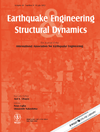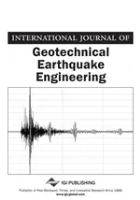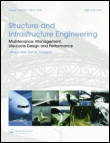
EARTHQUAKE ENGINEERING & STRUCTURAL DYNAMICS
Scope & Guideline
Pioneering methodologies for structural resilience.
Introduction
Aims and Scopes
- Seismic Performance Assessment:
The journal emphasizes research on evaluating the seismic performance of structures, including fragility and vulnerability assessments, performance-based design methodologies, and resilience strategies. - Innovative Seismic Design Techniques:
Papers often explore novel approaches to seismic design, including the use of advanced materials, damping systems, and isolation techniques to improve the resilience of structures. - Hybrid Simulation and Testing Methods:
The journal supports research that develops and utilizes hybrid simulation techniques, combining experimental and numerical approaches for more accurate structural response predictions under seismic loading. - Machine Learning and Data-Driven Approaches:
Emerging methodologies incorporating machine learning and data-driven techniques are a key focus, particularly in predicting seismic responses and assessing structural health. - Soil-Structure Interaction:
Research on the interaction between soil and structural systems during seismic events is extensively covered, highlighting the importance of ground conditions on structural performance. - Retrofitting and Rehabilitation Strategies:
The journal includes studies on retrofitting existing structures to enhance their seismic resilience, focusing on practical applications and innovative solutions.
Trending and Emerging
- Machine Learning Applications:
The integration of machine learning techniques for earthquake damage prediction, structural analysis, and assessment is gaining momentum, highlighting the role of big data in enhancing seismic resilience. - Advanced Damping and Isolation Systems:
There is an increasing focus on developing and testing innovative damping and isolation systems, such as shape memory alloys and tuned mass dampers, to improve the seismic performance of structures. - Resilience and Recovery Frameworks:
Research centered on resilience and recovery strategies for post-earthquake scenarios is trending, reflecting a broader understanding of the need for sustainable disaster management. - Real-Time Hybrid Simulation:
The use of real-time hybrid simulation methodologies is emerging as a significant area of interest, enabling more accurate assessments of structural responses under realistic seismic scenarios. - Integrated Risk Assessment Models:
There is a growing emphasis on the development of integrated models that combine various hazards—earthquake, wind, and flooding—to assess overall structural risk and resilience. - Sustainable and Eco-Friendly Design Approaches:
Emerging themes include the exploration of sustainable materials and eco-friendly design practices in earthquake engineering, responding to global sustainability challenges.
Declining or Waning
- Traditional Static Analysis Methods:
There has been a noticeable decrease in publications focusing on traditional static analysis methods for earthquake design, as the field increasingly favors dynamic and performance-based approaches. - Basic Seismic Hazard Assessment Techniques:
Research papers dedicated to fundamental seismic hazard assessment techniques are becoming less frequent, likely due to the integration of more sophisticated probabilistic and site-specific methodologies. - Conventional Material Studies:
Studies concentrating solely on conventional materials without a focus on innovative or hybrid materials are waning, as there is a growing trend towards exploring advanced materials and their seismic performance. - Non-dynamic Approaches to Structural Health Monitoring:
Research on static or non-dynamic methods for structural health monitoring is declining, with a shift towards more dynamic and real-time monitoring techniques.
Similar Journals

Advanced Steel Construction
Pioneering Research in Structural Engineering ExcellenceAdvanced Steel Construction is a prominent journal published by the Hong Kong Institute of Steel Construction, dedicated to the field of structural engineering and material sciences with a specific focus on steel construction techniques and advancements. Since its inception in 2005, the journal has established itself as a valuable resource for researchers, professionals, and students alike, offering insights into the latest developments and innovative practices within the realms of building construction, civil engineering, and materials mechanics. With its recognition as a Q2 journal across multiple engineering categories, including Building and Construction, Civil and Structural Engineering, Mechanical Engineering, and Mechanics of Materials, it ranks competitively in Scopus rankings, highlighting its significance in academic discourse. The journal is based in China, at the Hong Kong Polytechnic University, and provides an essential platform for sharing groundbreaking research and fostering collaboration within the engineering community.

Earthquakes and Structures
Connecting theory and practice in earthquake engineering.Earthquakes and Structures is a prestigious academic journal published by TECHNO-PRESS, dedicated to the field of Civil and Structural Engineering. Since its inception in 2010, this journal has provided a platform for innovative research and practical applications, addressing critical challenges related to seismic activities and their impact on infrastructure. With an ISSN of 2092-7614 and an E-ISSN of 2092-7622, it is indexed in top databases, reflecting its commitment to quality and relevance, as indicated by its Q3 quartile ranking in 2023. The journal encompasses a wide range of topics, from theoretical investigations to real-world case studies, appealing to researchers, professionals, and students alike. By fostering interdisciplinary collaboration and disseminating cutting-edge findings, Earthquakes and Structures plays an essential role in advancing knowledge and practices in earthquake engineering, enhancing global resilience against seismic threats.

International Journal of Geotechnical Earthquake Engineering
Elevating global discourse on earthquake impacts in geotechnical engineering.International Journal of Geotechnical Earthquake Engineering, published by IGI Global, serves as a pivotal platform for researchers and practitioners in the field of geotechnical engineering and engineering geology. Established in 2010, this journal has steadily promoted the dissemination of innovative research and advancements in understanding the impact of seismic activities on soil behavior and structural integrity. Operating out of the United States, it caters to a global audience and offers a range of articles that delve deep into the dynamics of earthquake engineering. With a 2023 Scopus ranking placing it in the 39th percentile among its peers and a Q4 designation in the relevant quartile, the journal actively seeks to elevate the discussion around geotechnical challenges associated with seismic events. While currently not classified as an Open Access journal, it remains committed to providing valuable insights that aid in the prevention and mitigation of geotechnical failures during earthquakes. Researchers, professionals, and students alike will find this journal an essential resource for the latest developments and practical applications in this ever-evolving field.

Journal of Structural Integrity and Maintenance
Exploring Cutting-edge Research in Structural IntegrityThe Journal of Structural Integrity and Maintenance, published by Taylor & Francis Ltd, serves as a prestigious platform dedicated to the advancement of knowledge in the fields of structural integrity, civil engineering, and materials science. With an ISSN of 2470-5314 and an E-ISSN of 2470-5322, this journal is uniquely positioned to address the critical challenges faced by researchers and professionals in building and construction, mechanical engineering, and related domains. Since its inception in 2016, this journal has been consistently recognized for its quality, currently holding a Q2 rank across several disciplines, including Building and Construction and Civil and Structural Engineering in 2023. The journal aims to publish high-quality research that contributes to the understanding and maintenance of structural integrity, fostering innovations that promote safety, efficiency, and sustainability in engineering practices. Researchers and students alike are encouraged to engage with this rich repository of knowledge, which plays a vital role in shaping future advancements in structural engineering and materials science.

Periodica Polytechnica-Civil Engineering
Championing Quality Research in Civil and Structural EngineeringPeriodica Polytechnica-Civil Engineering is a prestigious journal published by the Budapest University of Technology and Economics, dedicated to advancing the field of civil engineering through high-quality research and innovative practices. Established in 1972, the journal has transitioned through various phases of publication and now spans an expansive range of topics within civil and structural engineering, geotechnical engineering, and engineering geology. With an impact factor indicating its growing influence and a commendable placement in the Q3 quartile according to the latest 2023 metrics, it recognizes contributions that bridge theoretical advancements with practical applications. While currently not open access, the journal remains a vital resource for researchers, professionals, and students seeking to stay abreast of the latest developments in engineering design, construction techniques, and geotechnical innovations. The continuous publication of significant research after almost five decades underscores its commitment to disseminating knowledge crucial for the world’s infrastructure challenges, making it an essential reference point within the engineering community.

Teknik Dergi
Navigating the Evolving Landscape of EngineeringTeknik Dergi is a key academic journal published by the Turkish Chamber of Civil Engineers, focusing on the critical fields of Building and Construction as well as Civil and Structural Engineering. Established in Turkey, this journal serves as a vital platform for researchers, practitioners, and students to disseminate innovative findings and advancements within these disciplines. Although its coverage in databases like Scopus has been discontinued since 2022, Teknik Dergi remains a respected resource for its historical contributions, with a record of publication spanning from 1990 to 1998 and then from 2002 to 2022. The journal currently holds a Q4 categorization in both its primary fields, ranking within the 30th and 25th percentiles respectively. Authors and readers can access articles exploring practical applications and theoretical foundations, making it a valuable asset for those engaged in the rapidly evolving landscape of civil engineering. Open Access options are also available, allowing for broader dissemination and engagement with its published work.

STRUCTURAL ENGINEERING AND MECHANICS
Transforming Engineering Challenges into SolutionsSTRUCTURAL ENGINEERING AND MECHANICS, a leading journal published by TECHNO-PRESS, stands at the forefront of research in the disciplines of civil, structural, and mechanical engineering. With an ISSN of 1225-4568 and an E-ISSN of 1598-6217, this South Korea-based journal has been a significant contributor to the academic community since its inception in 1994, and it continues to disseminate vital research through 2024 and beyond. Achieving a Q3 ranking in key categories such as Building and Construction, Civil and Structural Engineering, Mechanical Engineering, and Mechanics of Materials, the journal is recognized for its high standard of academic rigour and relevance in contemporary engineering challenges. Although not Open Access, it offers robust access options for institutions and professionals seeking to advance their understanding of structural systems and mechanics. Researchers, students, and practitioners in these fields will find invaluable insights and innovative studies that push the boundaries of knowledge, making this journal an essential resource for anyone invested in engineering advancements.

Structure and Infrastructure Engineering
Transforming Challenges into Engineering TriumphsStructure and Infrastructure Engineering, published by TAYLOR & FRANCIS LTD, is a premier academic journal that serves as a vital resource in the fields of engineering and construction. Featuring an ISSN of 1573-2479 and an E-ISSN of 1744-8980, this journal has established its reputation as a leader in disseminating high-quality research. Since its inception, it has successfully transitioned through converged years from 2007 to 2024, earning a prestigious position within the Q1 quartile across multiple engineering disciplines, including Building and Construction, Civil and Structural Engineering, and Ocean Engineering, among others. Its impact is underscored by impressive Scopus rankings, particularly its 5th rank in Ocean Engineering within the top 95th percentile. The journal’s commitment to advancing knowledge in safety, risk, reliability, and quality makes it an indispensable platform for researchers, professionals, and students aiming to stay at the forefront of engineering innovations. Access to its comprehensive articles allows for a deeper understanding of contemporary challenges and solutions in infrastructure development.

Earthquake Engineering and Engineering Vibration
Uniting global experts in the quest for seismic safety.Earthquake Engineering and Engineering Vibration, published by Springer, is a leading international journal dedicated to the field of earthquake engineering, structural dynamics, and the associated vibrational research integral to understanding and mitigating seismic risks. With its print ISSN 1671-3664 and E-ISSN 1993-503X, the journal operates from its headquarters in New York, USA. The journal has achieved a commendable Q2 category ranking across multiple engineering disciplines, reflecting its importance to the building and construction, civil and structural engineering, geophysics, geotechnical engineering, and mechanical engineering fields. The journal serves as a vital platform for researchers, practitioners, and students to disseminate their findings, share innovative methodologies, and contribute to advancements in earthquake resilience and engineering practices. Earthquake Engineering and Engineering Vibration is committed to fostering open dialogue and collaboration within the global research community, ensuring that its contributions are both impactful and relevant to contemporary challenges in engineering and environmental safety.

Electronic Journal of Structural Engineering
Fostering Collaboration in Structural Engineering AdvancementsThe Electronic Journal of Structural Engineering (ISSN: 1443-9255), published by EJSE INT LTD, serves as a vital platform for disseminating innovative research and developments in the field of structural engineering. Since its inception in 2001, the journal has evolved to embrace an Open Access model starting in 2022, ensuring that cutting-edge findings are freely accessible to researchers, professionals, and students worldwide. Housed within the reputable Department of Infrastructure Engineering at the University of Melbourne, Australia, the journal focuses on a wide range of topics related to civil and structural engineering, positioning itself within the Q4 category on the 2023 Scopus rankings. While its H-index and detailed scope data are currently unavailable, the journal's commitment to quality research is evident through its continuous publication and engagement with the global academic community. With significant implications for contemporary engineering practices, The Electronic Journal of Structural Engineering not only fosters scholarly discourse but also encourages practical applications of structural engineering advancements.